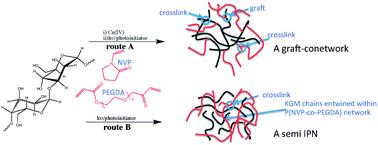Glucomannan-poly(N-vinyl pyrrolidinone) bicomponent hydrogels for wound healing†
Abstract
Polysaccharides interact with cells in ways that can be conducive to wound healing. We have recently reported that konjac glucomannan (KGM) which is comprised of D-mannose and D-glucose linked by β-1,4 glycosidic chains, stimulates fibroblast proliferation. The aim of this study was to produce a range of crosslinked KGMs and bicomponent KGM containing hydrogels and to examine their potential for wound healing. Two types of KGM hydrogel were synthesized, biodegradable from crosslinked KGM and non-biodegradable by forming semi-IPNs and graft-conetworks with a second synthetic component, poly(N-vinyl pyrrolidinone-co-poly(ethyleneglycol)diacrylate) (P(NVP-co-PEGDA)), which was produced by UV initiated radical polymerization. Crosslinked KGM was formed by bimolecular termination of macro-radicals formed by oxidation with Ce(IV). Semi-IPNs were formed by copolymerization of NVP and PEGDA in the presence of KGM and in the graft-conetworks the KGM was also crosslinked using the Ce(IV) procedure. The hydrogels had different swelling properties and differences could be observed in their chemical structure using 13C solid state NMR, DSC and FTIR. Both forms were cytocompatible but only the graft-conetworks had the ability to stimulate fibroblast metabolic activity and to stimulate the migration of both fibroblasts and keratinocytes. In conclusion a form of KGM hydrogel has been produced that could benefit wound healing.


 Please wait while we load your content...
Please wait while we load your content...